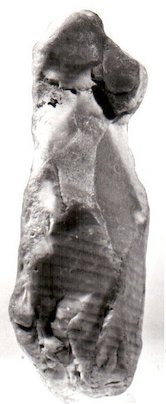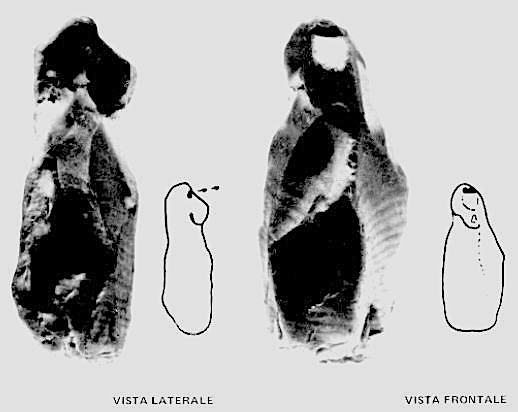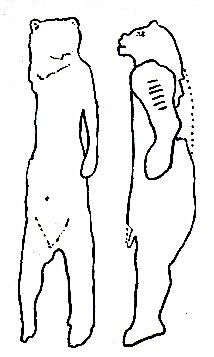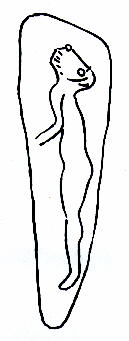- from 400,000 to 200,000 years ago (Acheulean and Middle Clactonian);
- from 200,000 to 40,000 years ago (final Acheulean and Clactonian, and Mousterian);
- from 40,000 to 12,000 years ago (Upper Paleolithic).
The typology of the sculptures is comprised of several types of artistic hybrids that represent the head of an animal attached to a vertical human body.
The most ancient sculpture from the Lower Paleolithic is in flint (Fig. 10.1). In the Upper Paleolithic (Aurignacian) sites they are also found carved in ivory (Fig. 10.2); and in the Magdalenian also engraved on stone (Fig. 10.3).
This typology in religion continues in the Mesolithic, and in all the historic urban civilizations, among them the greatest sculptures ever found from ancient Egypt and India.


Fig. 10.1) Zooanthropomorphic stone sculpture representing an artistic man-animal hybrid with a mammal head and a vertical human body.
(In ancient Egypt, the Goddess Thueris had a hippopotamus head and a vertical human body with a large belly; she was one of the oldest popular deities, and was much venerated by pregnant women).
This small sculpture is in flint, and is completely worked across the entire surface.
Height: 2.5 inches.
Origin: Rodi Garganico, Foggia, Italy.
Material culture: Clactonian or Middle Acheulean.
Collection of the Museum of the Origins of Man.

Height: 12.2 inches. Width: 2.3 inches.
Origin: Hohlenstein-Stadel cave, Lonetal Valley, Baden-Württemberg, Germany.
Material culture: Upper Paleolithic (Aurignacian).
Absolute dating: 30,000 years ago.
Location: Museum Ulm, Germany.

Height: 3.6 inches.
Origin: La Madeleine cave, Tursac, France.
Material culture: Upper Paleolithic.
National Archeological Museum (Musée des Antiquités nationales), Saint-Germain-en-Laye, Paris.
Copyright©2020 by Museum of the Origins of Man, all rights reserved.